Abstract
Two clostridocins distinguishable by their different modes of action on Clostridium pasteurianum have been isolated, namely, butyricin 7423 found in cultures of Clostridium butyricum NCIB 7423 and perfringocin 11105 produced by Clostridium perfringens type A, NCIB 11105. Both were trypsin-susceptible proteins which were soluble in concentrated aqueous ethanol and were able to bind large amounts of the nonionic detergent Triton X-100. In the presence of Triton X-100, butyricin 7423 behaved as a hydrophobic protein in being concentrated in the polyethylene glycol layer of a three-phase partition system of dextran-Ficoll-polyethylene glycol. Their capacity to bind Triton X-100 was exploited in a purification procedure applicable to both bacteriocins. After aqueous ethanol extraction of an ammonium sulfate-precipitated fraction (and, in the case of the perfringocin, a heat-treatment step), a bacteriocin-Triton X-100 adduct was purified by gel filtration through Sepharose 6B. The bacteriocin was then freed of Triton X-100 by chromatography on Sephadex LH-20. Samples of butyricin 7423 purified in this way from different sources contained variable amounts of carbohydrate. Yet sodium dodecyl sulfate-gel electrophoresis revealed the existence of a polypeptide component of 32,500 daltons (±10%), which displayed the biological activity of butyricin 7423 in the absence of any detectable associated carbohydrate (or lipid). Preparations of perfringocin 11105 contained no carbohydrate or lipid and migrated in sodium dodecyl sulfate-gel electrophoresis as a single protein component of 76,000 daltons (±10%). It was concluded that both bacteriocins behave as amphiphilic proteins, and some implications of this finding are considered.
Full text
PDF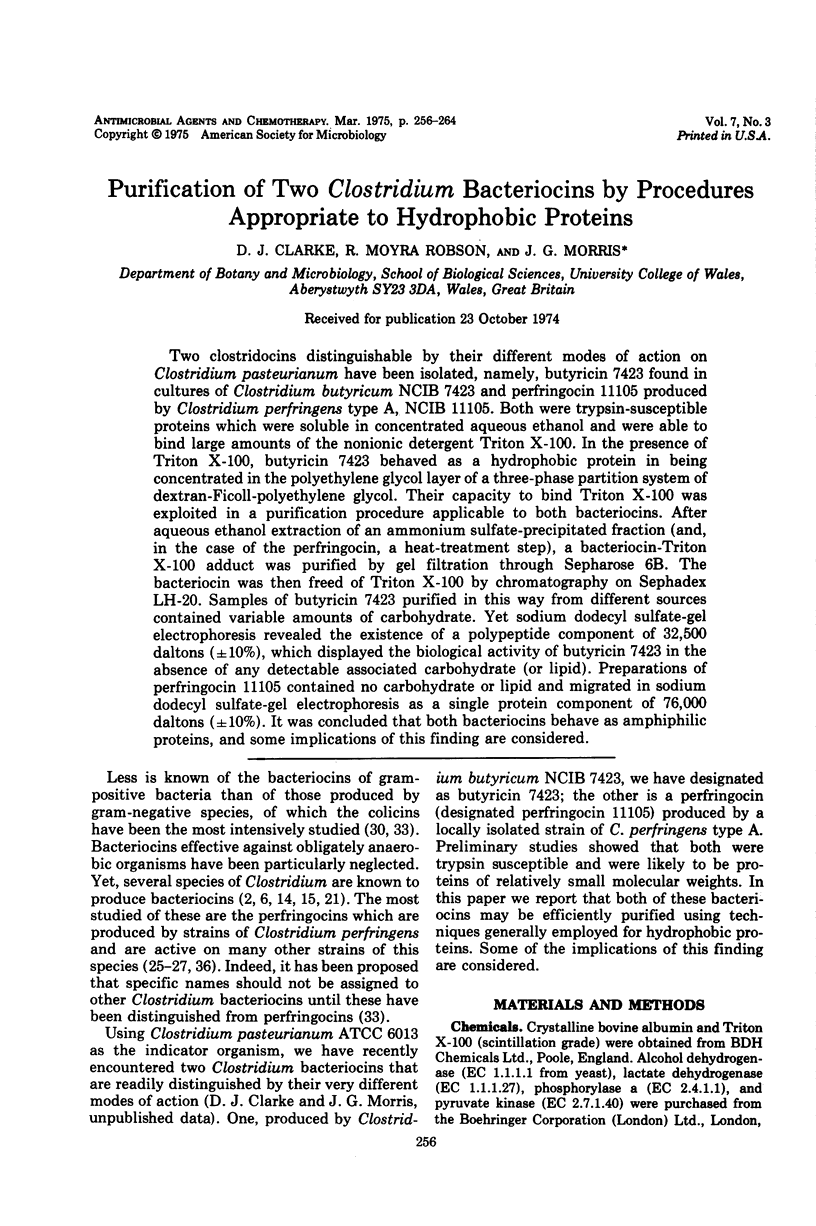

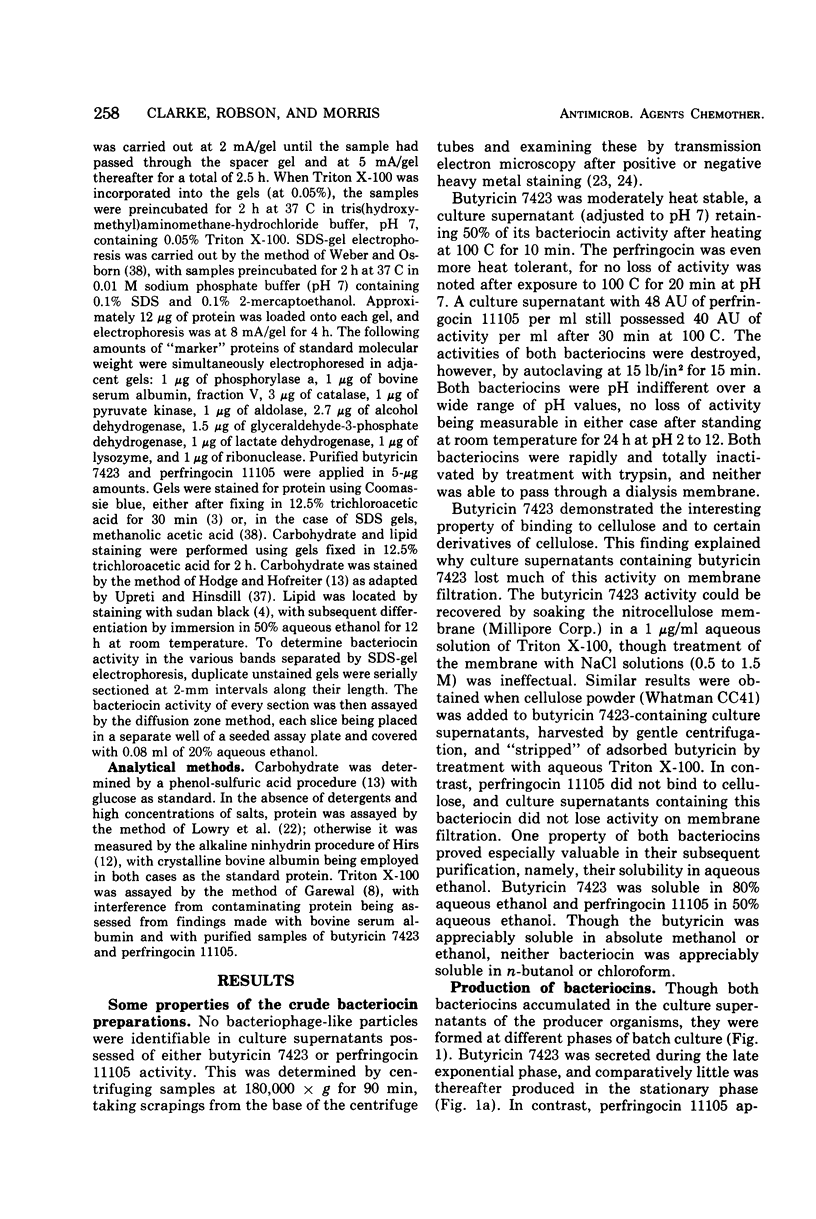
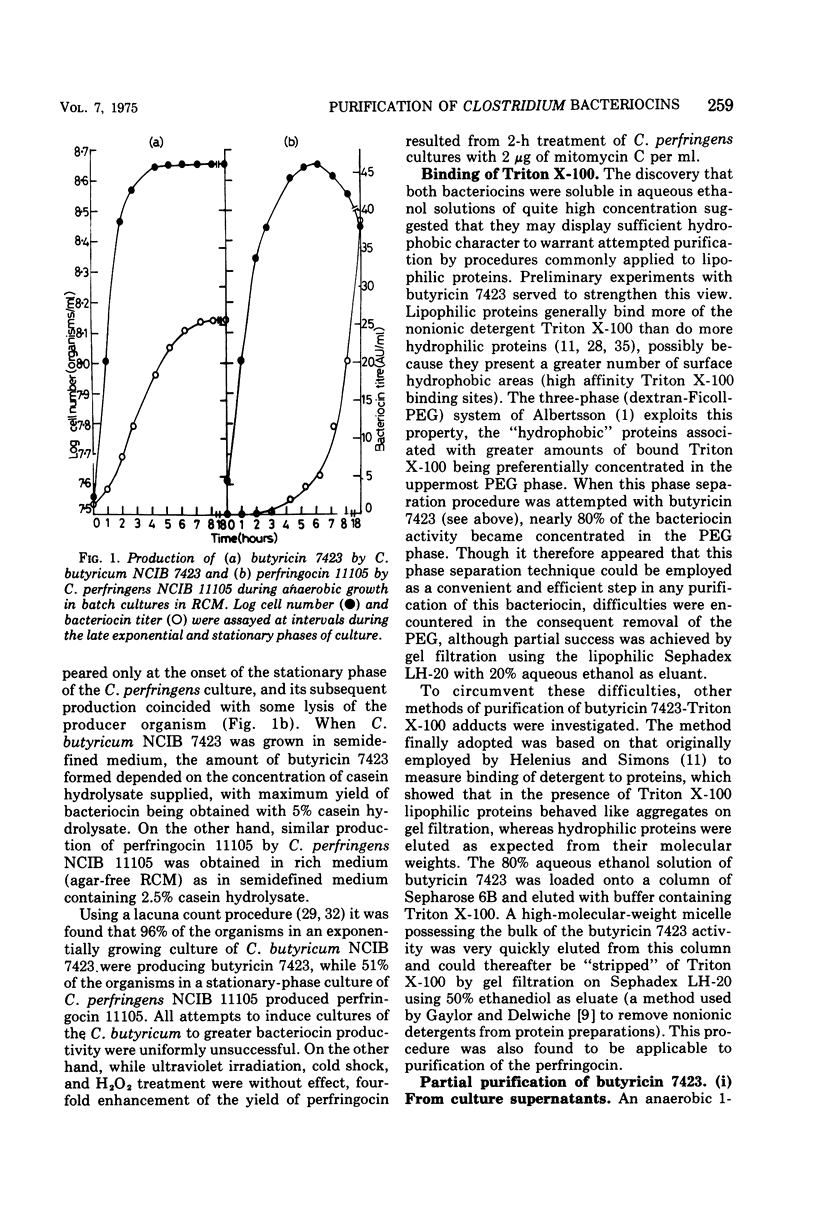



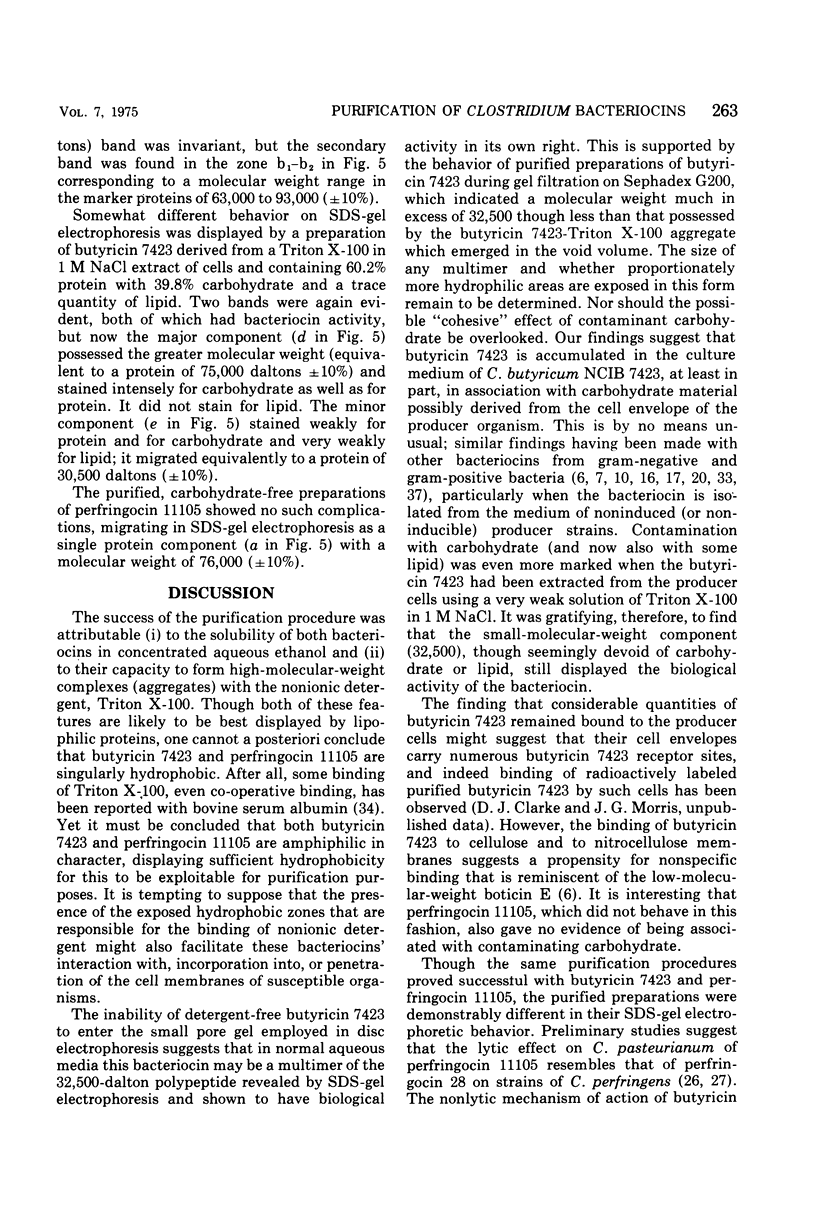
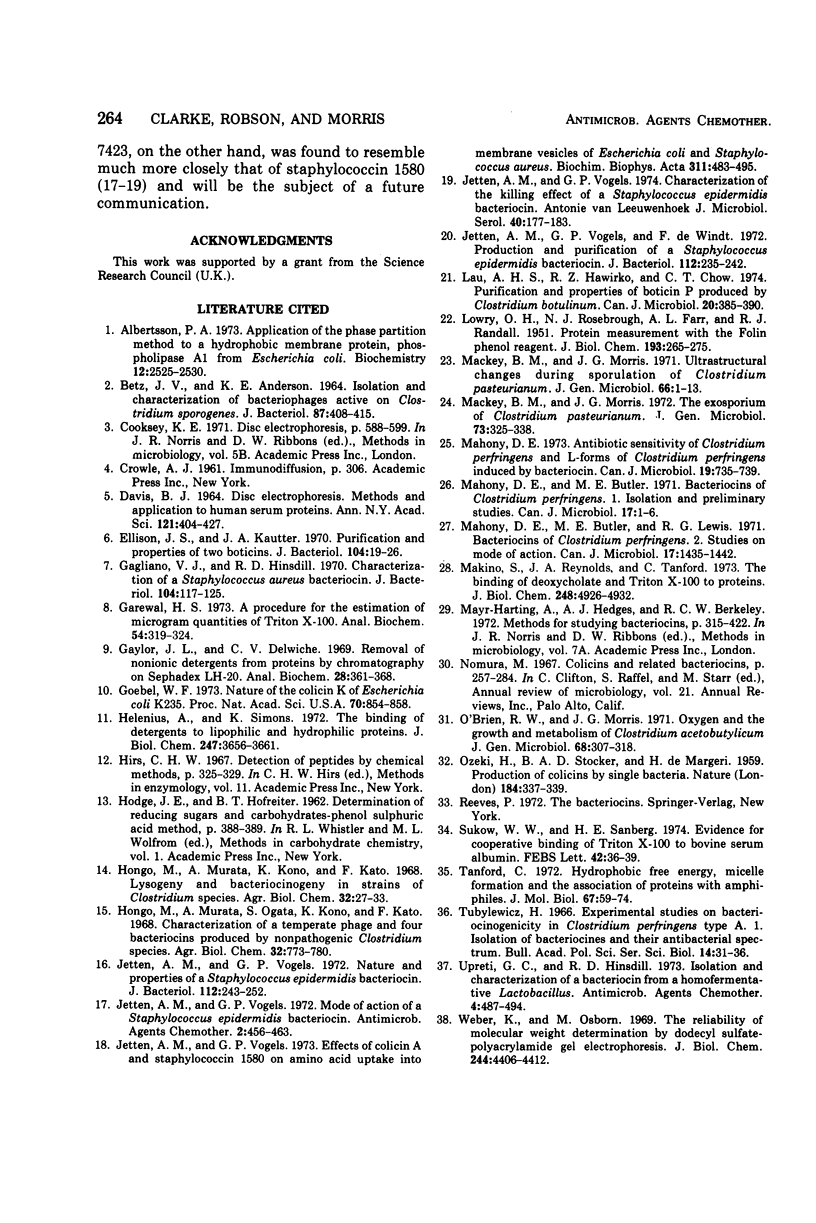
Selected References
These references are in PubMed. This may not be the complete list of references from this article.
- Albertsson P. A. Application of the phase partition method to a hydrophobic membrane protein, phospholipase A1 from Escherichia coli. Biochemistry. 1973 Jun 19;12(13):2525–2530. doi: 10.1021/bi00737a024. [DOI] [PubMed] [Google Scholar]
- BETZ J. V., ANDERSON K. E. ISOLATION AND CHARACTERIZATION OF BACTERIOPHAGES ACTIVE ON CLOSTRIDIUM SPOROGENES. J Bacteriol. 1964 Feb;87:408–415. doi: 10.1128/jb.87.2.408-415.1964. [DOI] [PMC free article] [PubMed] [Google Scholar]
- DAVIS B. J. DISC ELECTROPHORESIS. II. METHOD AND APPLICATION TO HUMAN SERUM PROTEINS. Ann N Y Acad Sci. 1964 Dec 28;121:404–427. doi: 10.1111/j.1749-6632.1964.tb14213.x. [DOI] [PubMed] [Google Scholar]
- Ellison J. S., Kautter J. A. Purification and some properties of two boticins. J Bacteriol. 1970 Oct;104(1):19–26. doi: 10.1128/jb.104.1.19-26.1970. [DOI] [PMC free article] [PubMed] [Google Scholar]
- Gagliano V. J., Hinsdill R. D. Characterization of a Staphylococcus aureus bacteriocin. J Bacteriol. 1970 Oct;104(1):117–125. doi: 10.1128/jb.104.1.117-125.1970. [DOI] [PMC free article] [PubMed] [Google Scholar]
- Garewal H. S. A procedure for the estimation of microgram quantities of triton X-100. Anal Biochem. 1973 Aug;54(2):319–324. doi: 10.1016/0003-2697(73)90359-x. [DOI] [PubMed] [Google Scholar]
- Gaylor J. L., Delwiche C. V. Removal of nonionic detergents from proteins by chromatography on sephadex LH-20. Anal Biochem. 1969 Apr 4;28(1):361–368. doi: 10.1016/0003-2697(69)90191-2. [DOI] [PubMed] [Google Scholar]
- Goebel W. F. The nature of the colicin K of Escherichia coli K235. Proc Natl Acad Sci U S A. 1973 Mar;70(3):854–858. doi: 10.1073/pnas.70.3.854. [DOI] [PMC free article] [PubMed] [Google Scholar]
- Helenius A., Simons K. The binding of detergents to lipophilic and hydrophilic proteins. J Biol Chem. 1972 Jun 10;247(11):3656–3661. [PubMed] [Google Scholar]
- Jetten A. M., Vogels G. D. Characteristics of the killing effect of a Staphylococcus epidermidis bacteriocin. Antonie Van Leeuwenhoek. 1974;40(1):177–183. doi: 10.1007/BF00394565. [DOI] [PubMed] [Google Scholar]
- Jetten A. M., Vogels G. D. Effects of colicin A and staphylococcin 1580 on amino acid uptake into membrane vesicles of Escherichia coli and staphylococcus aureus. Biochim Biophys Acta. 1973 Jul 18;311(4):483–495. doi: 10.1016/0005-2736(73)90124-7. [DOI] [PubMed] [Google Scholar]
- Jetten A. M., Vogels G. D. Mode of action of a Staphylococcus epidermidis bacteriocin. Antimicrob Agents Chemother. 1972 Dec;2(6):456–463. doi: 10.1128/aac.2.6.456. [DOI] [PMC free article] [PubMed] [Google Scholar]
- Jetten A. M., Vogels G. D. Nature and properties of a Staphylococcus epidermidis bacteriocin. J Bacteriol. 1972 Oct;112(1):243–250. doi: 10.1128/jb.112.1.243-250.1972. [DOI] [PMC free article] [PubMed] [Google Scholar]
- Jetten A. M., Vogels G. D., de Windt F. Production and purification of a Staphylococcus epidermidis bacteriocin. J Bacteriol. 1972 Oct;112(1):235–242. doi: 10.1128/jb.112.1.235-242.1972. [DOI] [PMC free article] [PubMed] [Google Scholar]
- LOWRY O. H., ROSEBROUGH N. J., FARR A. L., RANDALL R. J. Protein measurement with the Folin phenol reagent. J Biol Chem. 1951 Nov;193(1):265–275. [PubMed] [Google Scholar]
- Lau A. H., Hawirko R. Z., Chow C. T. Purification and properties of boticin P produced by Clostridium botulinum. Can J Microbiol. 1974 Mar;20(3):385–390. doi: 10.1139/m74-059. [DOI] [PubMed] [Google Scholar]
- Mackey B. M., Morris J. G. The exosporium of Clostridium pasteurianum. J Gen Microbiol. 1972 Nov;73(2):325–338. doi: 10.1099/00221287-73-2-325. [DOI] [PubMed] [Google Scholar]
- Mahony D. E. Antibiotic sensitivity of Clostridium perfringens and L-forms of C. perfringens induced by bacteriocin. Can J Microbiol. 1973 Jun;19(6):735–739. doi: 10.1139/m73-118. [DOI] [PubMed] [Google Scholar]
- Mahony D. E., Butler M. E. Bacteriocins of Clostridium perfringens. 1. Isolation and preliminary studies. Can J Microbiol. 1971 Jan;17(1):1–6. doi: 10.1139/m71-001. [DOI] [PubMed] [Google Scholar]
- Mahony D. E., Butler M. E., Lewis R. G. Bacteriocins of Clostridium perfringens. 2. Studies on mode of action. Can J Microbiol. 1971 Nov;17(11):1435–1442. doi: 10.1139/m71-228. [DOI] [PubMed] [Google Scholar]
- Makino S., Reynolds J. A., Tanford C. The binding of deoxycholate and Triton X-100 to proteins. J Biol Chem. 1973 Jul 25;248(14):4926–4932. [PubMed] [Google Scholar]
- Nomura M. Colicins and related bacteriocins. Annu Rev Microbiol. 1967;21:257–284. doi: 10.1146/annurev.mi.21.100167.001353. [DOI] [PubMed] [Google Scholar]
- O'Brien R. W., Morris J. G. Oxygen and the growth and metabolism of Clostridium acetobutylicum. J Gen Microbiol. 1971 Nov;68(3):307–318. doi: 10.1099/00221287-68-3-307. [DOI] [PubMed] [Google Scholar]
- OZEKI H., STOCKER B. A., DE MARGERIE H. Production of colicine by single bacteria. Nature. 1959 Aug 1;184:337–339. doi: 10.1038/184337a0. [DOI] [PubMed] [Google Scholar]
- Sukow W. W., Sandberg H. E. Evidence for cooperative binding of Triton X-100 to bovine serum albumin. FEBS Lett. 1974 May 15;42(1):36–41. doi: 10.1016/0014-5793(74)80273-5. [DOI] [PubMed] [Google Scholar]
- Tanford C. Hydrophobic free energy, micelle formation and the association of proteins with amphiphiles. J Mol Biol. 1972 Jun 14;67(1):59–74. doi: 10.1016/0022-2836(72)90386-5. [DOI] [PubMed] [Google Scholar]
- Tubylewicz H. Experimental studies on bacteriocinogeneity in Clostridium perfringens type A. I. Isolation of bacteriocines and their antibacterial spectrum. Bull Acad Pol Sci Biol. 1966;14(1):31–36. [PubMed] [Google Scholar]
- Upreti G. C., Hinsdill R. D. Isolation and characterization of a bacteriocin from a homofermentative Lactobacillus. Antimicrob Agents Chemother. 1973 Oct;4(4):487–494. doi: 10.1128/aac.4.4.487. [DOI] [PMC free article] [PubMed] [Google Scholar]
- Weber K., Osborn M. The reliability of molecular weight determinations by dodecyl sulfate-polyacrylamide gel electrophoresis. J Biol Chem. 1969 Aug 25;244(16):4406–4412. [PubMed] [Google Scholar]


